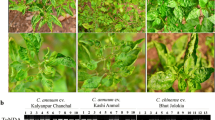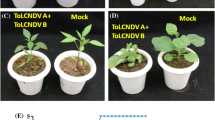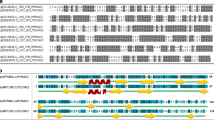Abstract
Mixed viral infections are common in fields and frequently exacerbate disease severity via synergistic interactions among individual viral genomic components leading to major crop loss. Two predominant species of tomato-infecting begomoviruses, Tomato leaf curl New Delhi virus (ToLCNDV) and Tomato leaf curl Gujarat virus (ToLCGuV), are known to cause severe leaf curl disease of tomato in India. Previously, we have demonstrated asymmetric synergism between these two distinct begomovirus species during mixed infection in solanaceous hosts. In the present study, we have identified the underlying proteins that positively regulate asymmetric synergism and their effect on plant defense machinery. During co-infection, the AC2 and AV2 of ToLCGuV enhanced ToLCNDV DNA accumulation in Nicotiana benthamiana as well as in their natural host, tomato. Furthermore, we found that AC2 and AV2 of ToLCNDV and AV2 of ToLCGuV play a critical role in suppression of post transcriptional gene silencing (PTGS) machinery. Taken together, AC2 and AV2 encoded proteins of ToLCGuV are the crucial viral factors promoting asymmetric synergism with ToLCNDV.
Key points
• Begomoviral suppressors play vital roles in viral synergism.
• AC2 and AV2 of ToLCGuV asymmetrically enhance ToLCNDV accumulation.
• AC2 and AV2 of ToLCNDV and ToLCGuV AV2 are major PTGS suppressors.
Graphical abstract






Similar content being viewed by others
Data availability
All data generated or analyzed during this study are included in this published article (and its supplementary information files)
References
Adams MJ, Lefkowitz EJ, King AMQ, Harrach B, Harrison RL, Knowles NJ, Kropinski AM, Krupovic M, Kuhn JH, Mushegian AR, Nibert M, Sabanadzovic S, Sanfaçon H, Siddell SG, Simmonds P, Varsani A, Zerbini FM, Gorbalenya AE, Davison AJ (2016) Ratification vote on taxonomic proposals to the International Committee on Taxonomy of Viruses. Arch Virol 161:2921–2949. https://doi.org/10.1007/s00705-016-2977-6
Amin I, Hussain K, Akbergenov R, Yadav JS, Qazi J, Mansoor S, Hohn T, Fauquet CM, Briddon RW (2011) Suppressors of RNA silencing encoded by the components of the Cotton leaf curl begomovirus-betasatellite complex. Mol Plant-Microbe Interact 24:973–983. https://doi.org/10.1094/MPMI-01-11-0001
Anandalakshmi R, Pruss GJ, Ge X, Marathe R, Mallory AC, Smith TH, Vance VB (1998) A viral suppressor of gene silencing in plants. Proc Natl Acad Sci U S A 95:13079–13084. https://doi.org/10.1073/pnas.95.22.13079
Basu S, Kumar Kushwaha N, Kumar Singh A, Pankaj Sahu P, Vinoth Kumar R, Chakraborty S (2018) Dynamics of a geminivirus-encoded pre-coat protein and host RNA-dependent RNA polymerase 1 in regulating symptom recovery in tobacco. J Exp Bot 69:2085–2102. https://doi.org/10.1093/jxb/ery043
Baulcombe D (2004) RNA silencing in plants. Nature 431:356–363. https://doi.org/10.1038/nature02874
Cañizares MC, Liu L, Perrin Y, Tsakiris E, Lomonossoff GP (2006) A bipartite system for the constitutive and inducible expression of high levels of foreign proteins in plants. Plant Biotechnol J 4(2):183–193. https://doi.org/10.1111/j.1467-7652.2005.00170.x
Caracuel Z, Lozano-Durán R, Huguet S, Arroyo-Mateos M, Rodríguez-Negrete EA, Bejarano ER (2012) C2 from Beet curly top virus promotes a cell environment suitable for efficient replication of geminiviruses, providing a novel mechanism of viral synergism. New Phytol 194:846–858. https://doi.org/10.1111/j.1469-8137.2012.04080.x
Castillo-González C, Liu X, Huang C, Zhao C, Ma Z, Hu T, Sun F, Zhou Y, Zhou X, Wang X-J, Zhang X (2015) Geminivirus-encoded TrAP suppressor inhibits the histone methyltransferase SUVH4/KYP to counter host defense. Elife 4:e06671. https://doi.org/10.7554/eLife.06671
Ceniceros-Ojeda EA, Rodríguez-Negrete EA, Rivera-Bustamante RF (2016) Two populations of viral minichromosomes are present in a geminivirus-infected plant showing symptom remission (recovery). J Virol 90:3828–3838. https://doi.org/10.1128/JVI.02385-15
Chakraborty S (2008) In: Mahy BWJ, Van Regenmortel MHV (eds) Tomato leaf curl viruses from India. Encyclopedia of Virology, vol 5. Elsevier, Oxford, pp 124–133
Chakraborty S, Kumar M (2020) Tomato leaf curl New Delhi virus [Begomovirus, Geminiviridae]. Reference Module in Life Sciences, Encyclopedia of Virology 4th edition (edited by Dennis Bamford and Mark Zuckerman). Elsevier, Oxford. https://doi.org/10.1016/B978-0-12-809633-8.21561-6
Chakraborty S, Pandey PK, Banerjee MK, Kalloo G, Fauquet CM (2003) Tomato leaf curl Gujarat virus, a new begomovirus species causing a severe leaf curl disease of tomato in Varanasi, India. Phytopathology 93:1485–1495. https://doi.org/10.1094/PHYTO.2003.93.12.1485
Chakraborty S, Vanitharani R, Chattopadhyay B, Fauquet CM (2008) Supervirulent pseudorecombination and asymmetric synergism between genomic components of two distinct species of begomovirus associated with severe tomato leaf curl disease in India. J Gen Virol 89:818–828. https://doi.org/10.1099/vir.0.82873-0
Chávez-Calvillo G, Contreras-Paredes CA, Mora-Macias J, Noa-Carrazana JC, Serrano-Rubio AA, Dinkova TD, Carrillo-Tripp M, Silva-Rosales L (2016) Antagonism or synergism between papaya ringspot virus and papaya mosaic virus in Carica papaya is determined by their order of infection. Virology 489:179–191. https://doi.org/10.1016/j.virol.2015.11.026
Chellappan P, Vanitharani R, Ogbe F, Fauquet CM (2005) Effect of temperature on geminivirus-induced RNA silencing in plants. Plant Physiol 138:1828–1841. https://doi.org/10.1104/pp.105.066563
Cuellar WJ, Galvez M, Fuentes S, Tugume J, Kreuze J (2015) Synergistic interactions of begomoviruses with Sweet potato chlorotic stunt virus (genus Crinivirus) in sweet potato (Ipomoea batatas L.). Mol Plant Pathol 16:459–471. https://doi.org/10.1111/mpp.12200
Dellaporta SL, Wood J, Hicks JB (1983) A plant DNA minipreparation: version II. Plant Mol Biol Rep 1(4):19–21
Donaire L, Barajas D, Martínez-García B, Martínez-Priego L, Pagán I, Llave C (2008) Structural and genetic requirements for the biogenesis of Tobacco rattle virus-derived small interfering RNAs. J Virol 82(11):5167–5177. https://doi.org/10.1128/JVI.00272-08
Fauquet CM, Bisaro DM, Briddon RW, Brown JK, Harrison BD, Rybicki EP, Stenger DC, Stanley J (2003) Revision of taxonomic criteria for species demarcation in the family Geminiviridae, and an updated list of begomovirus species. Arch Virol 148:405–421. https://doi.org/10.1007/s00705-002-0957-5
Feinberg AP, Vogelstein B (1983) A technique for radiolabeling DNA restriction endonuclease fragments to high specific activity. Anal Biochem 132:6–13. https://doi.org/10.1016/0003-2697(83)90418-9
Fondong VN (2019) The ever-expanding role of C4/AC4 in geminivirus infection: punching above its weight? Mol Plant 12:145–147. https://doi.org/10.1016/j.molp.2018.12.006
Fukunaga R, Doudna JA (2009) dsRNA with 5’ overhangs contributes to endogenous and antiviral RNA silencing pathways in plants. EMBO J 28:545–555. https://doi.org/10.1038/emboj.2009.2
García-Arenal F, Zerbini FM (2019) Life on the edge: geminiviruses at the interface between crops and wild plant hosts. Annu Rev Virol 6:411–433. https://doi.org/10.1146/annurev-virology-092818-015536
García-Marcos A, Pacheco R, Martiáñez J, González-Jara P, Díaz-Ruíz JR, Tenllado F (2009) Transcriptional changes and oxidative stress associated with the synergistic interaction between Potato virus X and Potato virus Y and their relationship with symptom expression. Mol Plant-Microbe Interact 22:1431–1444. https://doi.org/10.1094/MPMI-22-11-1431
Garcia-Ruiz H, Takeda A, Chapman EJ, Sullivan CM, Fahlgren N, Brempelis KJ, Carrington JC (2010) Arabidopsis RNA-dependent RNA polymerases and dicer-like proteins in antiviral defense and small interfering RNA biogenesis during Turnip mosaic virus infection. Plant Cell 22:481–496. https://doi.org/10.1105/tpc.109.073056
Glick E, Zrachya A, Levy Y, Mett A, Gidoni D, Belausov E, Citovsky V, Gafni Y (2008) Interaction with host SGS3 is required for suppression of RNA silencing by Tomato yellow leaf curl virus V2 protein. Proc Natl Acad Sci U S A 105:157–161. https://doi.org/10.1073/pnas.0709036105
Goodman RM, Ross AF (1974) Enhancement of Potato virus X synthesis in doubly infected tobacco occurs in doubly infected cells. Virology 58:16–24. https://doi.org/10.1016/0042-6822(74)90137-8
Hameed A, Iqbal Z, Asad S, Mansoor S (2014) Detection of multiple potato viruses in the field suggests synergistic interactions among potato viruses in Pakistan. Plant Pathol J 30:407–415. https://doi.org/10.5423/PPJ.OA.05.2014.0039
Hamilton AJ, Baulcombe DC (1999) A species of small antisense RNA in posttranscriptional gene silencing in plants. Science 286:950–952. https://doi.org/10.1126/science.286.5441.950
Hamilton A, Voinnet O, Chappell L, Baulcombe D (2002) Two classes of short interfering RNA in RNA silencing. EMBO J 21:4671–4679. https://doi.org/10.1093/emboj/cdf464
Hanley-Bowdoin L, Bejarano ER, Robertson D, Mansoor S (2013) Geminiviruses: masters at redirecting and reprogramming plant processes. Nat Rev Microbiol 11(11):777–788. https://doi.org/10.1038/nrmicro3117
Herranz MC, Niehl A, Rosales M, Fiore N, Zamorano A, Granell A, Pallas V (2013) A remarkable synergistic effect at the transcriptomic level in peach fruits doubly infected by prunus necrotic ringspot virus and peach latent mosaic viroid. Virol J10(1). https://doi.org/10.1186/1743-422X-10-164
Horsch RB, Klee HJ (1986) Rapid assay of foreign gene expression in leaf discs transformed by Agrobacterium tumefaciens: role of T-DNA borders in the transfer process. Proc Natl Acad Sci U S A 83:4428–4432. https://doi.org/10.1073/pnas.83.12.4428
Kanakala S, Jyothsna P, Shukla R, Tiwari N, Veer BS, Swarnalatha P, Krishnareddy M, Malathi VG (2013) Asymmetric synergism and heteroencapsidation between two bipartite begomoviruses, Tomato leaf curl New Delhi virus and Tomato leaf curl Palampur virus. Virus Res 174:126–136. https://doi.org/10.1016/j.virusres.2013.03.011
Krupovic M, Ravantti JJ, Bamford DH (2009) Geminiviruses: a tale of a plasmid becoming a virus. BMC Evol Biol 9:112. https://doi.org/10.1186/1471-2148-9-112
Kumar RV, Sharma VK, Chattopadhyay B, Chakraborty S (2012) An improved plant regeneration and Agrobacterium-mediated transformation of red pepper (Capsicum annuum L.). Physiol Mol Biol Plants 18:357–364. https://doi.org/10.1007/s12298-012-0132-8
Kumar RV, Singh D, Singh AK, Chakraborty S (2017) Molecular diversity, recombination and population structure of alphasatellites associated with begomovirus disease complexes. Infect Genet Evol 49:39–47. https://doi.org/10.1016/j.meegid.2017.01.001
Kumari P, Singh AK, Chattopadhyay B, Chakraborty S (2010) Molecular characterization of a new species of begomovirus and betasatellite causing leaf curl disease of tomato in India. Virus Res 152:19–29. https://doi.org/10.1016/j.virusres.2010.05.015
Lewsey MG, Murphy AM, Maclean D, Dalchau N, Westwood JH, Macaulay K, Bennett MH, Moulin M, Hanke DE, Powell G, Smith AG, Carr JP (2010) Disruption of two defensive signaling pathways by a viral RNA silencing suppressor. Mol Plant-Microbe Interact 23:835–845. https://doi.org/10.1094/MPMI-23-7-0835
Luna AP, Morilla G, Voinnet O, Bejarano ER (2012) Functional analysis of gene-silencing suppressors from tomato yellow leaf curl disease viruses. Mol Plant-Microbe Interact 25:1294–1306. https://doi.org/10.1094/MPMI-04-12-0094-R
Mascia T, Gallitelli D (2016) Synergies and antagonisms in virus interactions. Plant Sci 252:176–192. https://doi.org/10.1016/j.plantsci.2016.07.015
Moreno AB, López-Moya JJ (2019) When viruses play team sports: mixed infections in plants. Phytopathology 110:29–48. https://doi.org/10.1094/PHYTO-07-19-0250-FI
Muniyappa V, Venkatesh HM, Ramappa HK, Kulkarni RS, Zeidan M, Tarba CY, Ghanim M, Czosnek H (2000) Tomato leaf curl virus from Bangalore (ToLCV-Ban4): sequence comparison with Indian ToLCV isolates, detection in plants and insects, and vector relationships. Arch Virol 145:1583–1598. https://doi.org/10.1007/s007050070078
Padidam M, Beachy RN, Fauquet CM (1995) Tomato leaf curl geminivirus from India has a bipartite genome and coat protein is not essential for infectivity. J Gen Virol 76(1):25–35. https://doi.org/10.1099/0022-1317-76-1-25
Padidam M, Beachy RN, Fauquet CM (1996) The role of AV2 (“precoat”) and coat protein in viral replication and movement in tomato leaf curl geminivirus. Virology 224:390–404. https://doi.org/10.1006/viro.1996.0546
Pallas V, García JA (2011) How do plant viruses induce disease? Interactions and interference with host components. J Gen Virol 92(12):2691–2705. https://doi.org/10.1099/vir.0.034603-0
Pilartz M, Jeske H (1992) Abutilon mosaic geminivirus double-stranded DNA is packed into minichromosomes. Virology 189:800–802. https://doi.org/10.1016/0042-6822(92)90610-2
Pumplin N, Voinnet O (2013) RNA silencing suppression by plant pathogens: defence, counter-defence and counter-counter-defence. Nat Rev Microbiol 11:745–760. https://doi.org/10.1038/nrmicro3120
Ranjan P, Kumar RV, Chakraborty S (2013) Differential pathogenicity among Tomato leaf curl Gujarat virus isolates from India. Virus Genes 47:524–531. https://doi.org/10.1007/s11262-013-0977-0
Ranjan P, Singh AK, Kumar RV, Basu S, Chakraborty S (2014) Host-specific adaptation of diverse betasatellites associated with distinct Indian tomato-infecting begomoviruses. Virus Genes 48:334–342. https://doi.org/10.1007/s11262-013-1031-y
Rentería-Canett I, Xoconostle-Cázares B, Ruiz-Medrano R, Rivera-Bustamante RF (2011) Geminivirus mixed infection on pepper plants: synergistic interaction between PHYVV and PepGMV. Virol J 8:104. https://doi.org/10.1186/1743-422X-8-104
Rochow WF, Ross AF (1955) Virus multiplication in plants doubly infected by potato viruses X and Y. Virology 1:10–27. https://doi.org/10.1016/0042-6822(55)90003-9
Roossinck MJ (1997) Mechanisms of plant virus evolution. Annu Rev Phytopathol 35:191–209. https://doi.org/10.1146/annurev.phyto.35.1.191
Sambrook J, Maccallum P, Russell D (2001) Molecular cloning: a laboratory manual, 3rd edn. Cold Spring Harbor Press, New York, p 2344
Sanderfoot AA, Lazarowitz SG (1996) Getting it together in plant virus movement: cooperative interactions between bipartite geminivirus movement proteins. Trends Cell Biol 6:353–358. https://doi.org/10.1016/0962-8924(96)10031-3
Sharma P, Ikegami M (2010) Tomato leaf curl Java virus V2 protein is a determinant of virulence, hypersensitive response and suppression of posttranscriptional gene silencing. Virology 396:85–93. https://doi.org/10.1016/j.virol.2009.10.012
Singh AK, Chattopadhyay B, Chakraborty S (2012) Biology and interactions of two distinct monopartite begomoviruses and betasatellites associated with radish leaf curl disease in India. Virol J 9:43. https://doi.org/10.1186/1743-422X-9-43
Singh AK, Kushwaha N, Chakraborty S (2016) Synergistic interaction among begomoviruses leads to the suppression of host defense-related gene expression and breakdown of resistance in chilli. Appl Microbiol Biotechnol 100:4035–4049. https://doi.org/10.1007/s00253-015-7279-5
Sufrin-Ringwald T, Lapidot M (2011) Characterization of a synergistic interaction between two cucurbit-infecting begomoviruses: Squash leaf curl virus and Watermelon chlorotic stunt virus. Phytopathology 101:281–289. https://doi.org/10.1094/PHYTO-06-10-0159
Syller J (2012) Facilitative and antagonistic interactions between plant viruses in mixed infections. Mol Plant Pathol 13:204–216. https://doi.org/10.1111/j.1364-3703.2011.00734.x
Syller J, Grupa A (2016) Antagonistic within-host interactions between plant viruses: molecular basis and impact on viral and host fitness. Mol Plant Pathol 17:769–782. https://doi.org/10.1111/mpp.12322
Torre C, Donaire L, Gómez-Aix C, Juárez M, Peterschmitt M, Urbino C, Hernando Y, Agüero J, Aranda MA (2018) Characterization of begomoviruses sampled during severe epidemics in tomato cultivars carrying the Ty-1 gene. Int J Mol Sci 19. https://doi.org/10.3390/ijms19092614
Vance VB (1991) Replication of potato virus X RNA is altered in coinfections with Potato virus Y. Virology 182:486–494. https://doi.org/10.1016/0042-6822(91)90589-4
Vance VB, Berger PH, Carrington JC, Hunt AG, Shi XM (1995) 5’ proximal potyviral sequences mediate Potato virus X/potyviral synergistic disease in transgenic tobacco. Virology 206:583–590. https://doi.org/10.1016/s0042-6822(95)80075-1
Vanitharani R, Chellappan P, Pita JS, Fauquet CM (2004) Differential roles of AC2 and AC4 of cassava geminiviruses in mediating synergism and suppression of posttranscriptional gene silencing. J Virol 78:9487–9498. https://doi.org/10.1128/JVI.78.17.9487-9498.2004
Varma A, Malathi VG (2003) Emerging geminivirus problems: a serious threat to crop production. Ann Appl Biol 142:145–164. https://doi.org/10.1111/j.1744-7348.2003.tb00240.x
Voinnet O, Lederer C, Baulcombe DC (2000) A viral movement protein prevents spread of the gene silencing signal in Nicotiana benthamiana. Cell 103:157–167. https://doi.org/10.1016/s0092-8674(00)00095-7
Wang X-B, Wu Q, Ito T, Cillo F, Li W-X, Chen X, Yu J-L, Ding S-W (2010) RNAi-mediated viral immunity requires amplification of virus-derived siRNAs in Arabidopsis thaliana. Proc Natl Acad Sci U S A 107:484–489. https://doi.org/10.1073/pnas.0904086107
Wang B, Li F, Huang C, Yang X, Qian Y, Xie Y, Zhou X (2014) V2 of Tomato yellow leaf curl virus can suppress methylation-mediated transcriptional gene silencing in plants. J Gen Virol 95(1):225–230. https://doi.org/10.1099/vir.0.055798-0
Xia Z, Zhao Z, Chen L, Li M, Zhou T, Deng C, Zhou Q, Fan Z (2016) Synergistic infection of two viruses MCMV and SCMV increases the accumulations of both MCMV and MCMV-derived siRNAs in maize. Sci Rep 6:20520. https://doi.org/10.1038/srep20520
Ying X-B, Dong L, Zhu H, Duan C-G, Du Q-S, Lv D-Q, Fang Y-Y, Garcia JA, Fang R-X, Guo H-S (2010) RNA-dependent RNA polymerase 1 from Nicotiana tabacum suppresses RNA silencing and enhances viral infection in Nicotiana benthamiana. Plant Cell 22:1358–1372. https://doi.org/10.1105/tpc.109.072058
Yu D, Liao L, Zhang Y, Xu K, Zhang J, Liu K, Li X, Tan G, Zheng J, He Y, Xu C, Zhao J, Fu B, Xie J, Mao J, Li C (2018) Development of a gateway-compatible pCAMBIA binary vector for RNAi-mediated gene knockdown in plants. Plasmid 98:52–55. https://doi.org/10.1016/j.plasmid.2018.09.002
Zarreen F, Chakraborty S (2020) Epigenetic regulation of geminivirus pathogenesis: a case of relentless recalibration of defence response in plants. J Exp Bot. https://doi.org/10.1093/jxb/eraa406
Zerbini FM, Briddon RW, Idris A, Martin DP, Moriones E, Navas-Castillo J, Rivera-Bustamante R, Roumagnac P, Varsani A, Ictv Report Consortium null (2017) ICTV virus taxonomy profile: Geminiviridae. J Gen Virol 98:131–133. https://doi.org/10.1099/jgv.0.000738
Zhang X-S, Holt J, Colvin J (2001) Synergism between plant viruses: a mathematical analysis of the epidemiological implications. Plant Pathol 50:732–746. https://doi.org/10.1046/j.1365-3059.2001.00613.x
Zhou C-J, Zhang X-Y, Liu S-Y, Wang Y, Li D-W, Yu J-L, Han C-G (2017) Synergistic infection of BrYV and PEMV 2 increases the accumulations of both BrYV and BrYV-derived siRNAs in Nicotiana benthamiana. Sci Rep 7:45132. https://doi.org/10.1038/srep45132
Zrachya A, Glick E, Levy Y, Arazi T, Citovsky V, Gafni Y (2007) Suppressor of RNA silencing encoded by Tomato yellow leaf curl virus-Israel. Virology 358:159–165. https://doi.org/10.1016/j.virol.2006.08.016
Acknowledgments
We thank Dr. Nirbhay Kumar Kushwaha for help in taking photographs of the suppressor assays. We also thank Dr. Vera Pfeiffer, Washington State University, for critical reading of the manuscript.
Funding
This work was sponsored by Department of Science and Technology, Government of India, New Delhi (India), vide grant no SR/SO/PS-87/2008. Saumik Basu, Divya Singh, and Ashish Kumar Singh acknowledge the University Grant Commission (UGC), India, for providing Senior Research Fellowship.
Author information
Authors and Affiliations
Contributions
S.B. and S.C. conceived the ideas and designed the methodologies for all the experiments performed in this study. S.B., A.K.S., D.S., and S.S. collected all the data. S.B., A.K.S., and S.C. analyzed all the data; S.B., A.K.S., and S.C. contributed critically to the draft and all authors gave final approval for publication.
Corresponding author
Ethics declarations
Conflict of interest
The authors declare that they have no competing interests.
Ethical statement
This research article does not contain any study with human participants or animals performed by any of the authors.
Additional information
Publisher’s note
Springer Nature remains neutral with regard to jurisdictional claims in published maps and institutional affiliations.
Supplementary information
ESM 1
(PDF 459 kb)
Rights and permissions
About this article
Cite this article
Basu, S., Singh, A.K., Singh, D. et al. Role of viral suppressors governing asymmetric synergism between tomato-infecting begomoviruses. Appl Microbiol Biotechnol 105, 1107–1121 (2021). https://doi.org/10.1007/s00253-020-11070-4
Received:
Revised:
Accepted:
Published:
Issue Date:
DOI: https://doi.org/10.1007/s00253-020-11070-4




